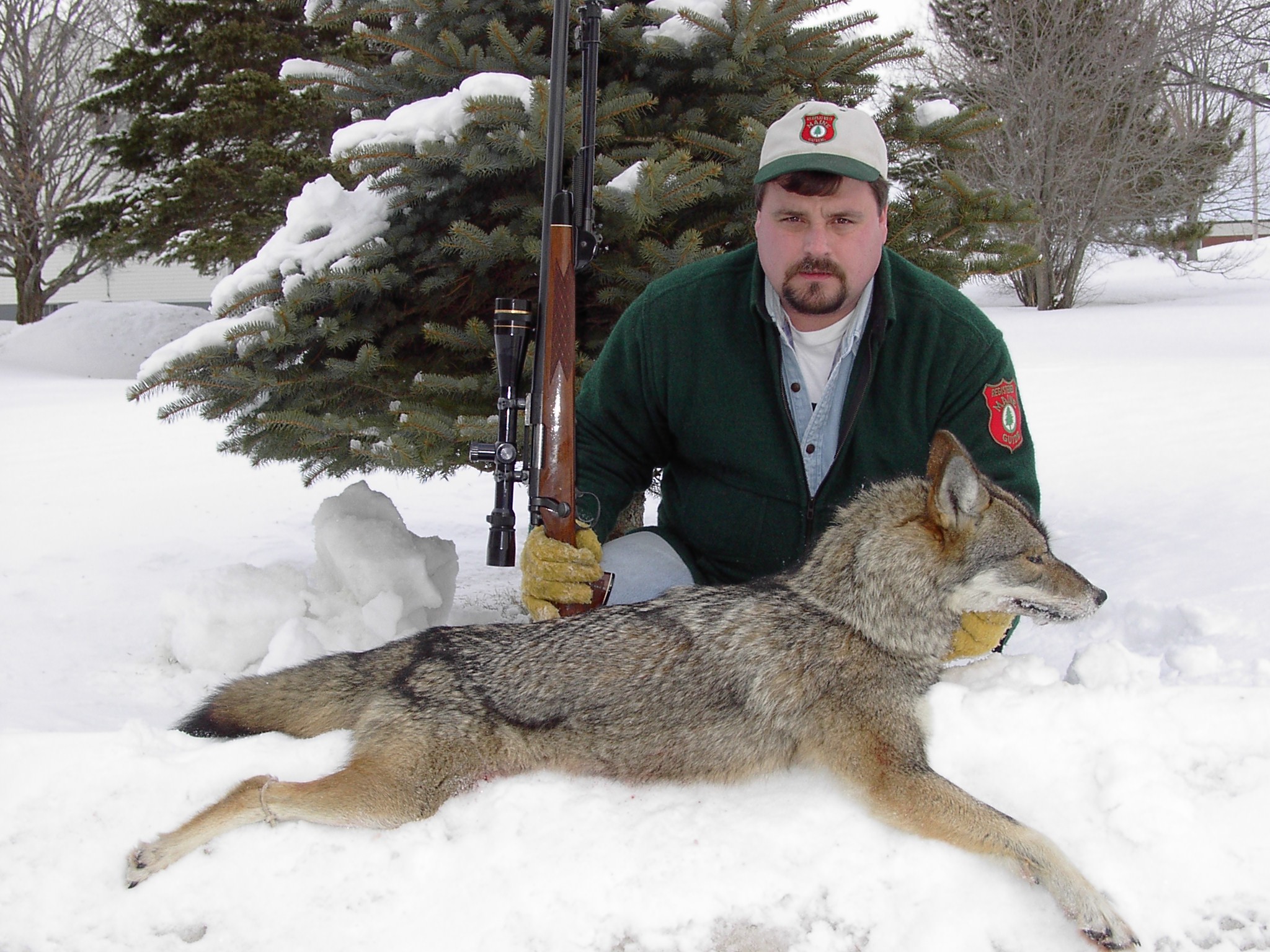I am not a big fan of coyotes. I am a believer in coyote hunting.
Regardless of the fact that the coyote-deer situation is natural predation, Aroostook’s harsh winters favor the predator, and in the end that notably affects the deer herd in certain areas. Anyone who has seen a pack of coy dogs relentlessly pursue a deer and down it, then begin feeding before the whitetail is dead, will share my support of varmint hunting.
Another view in support of coyote season is that these wary, wily predators are a true challenge for regional hunters. During the cold months when only two seasons are open to keep shooting and stalking skills keen, it’s either coyotes or rabbits. Snowshoe hare are easy to find and simple to hunt, but four-legged predators can offer County sportsmen a true test of calling skills, woodsmanship and marksmanship.
There are three basic methods of gunning for coyotes, some simpler and far more productive than the others. The easiest and most comfortable style of varmint hunting is to drive and spot. Although spotting a coyote while cruising woods roads is possible, the dogs are usually at close range and flee for cover immediately, allowing little chance for a shot. Occasionally a shooter will enjoy a bit of luck and down a too-slow or too-curious quarry.
Driving through open farm country and scanning roadside fields is a better way to sight coyotes. Using a good set of binoculars to search distant wood lines will further improve the odds. Then it’s just a matter of getting a shot before spooking the animal. Long-range, flat-shooting rifles with crisp, high-power optics are essential to anchoring a coy dog across a large open field.

Setting up a bait site to attract meat-hungry coyotes is another option for getting a clear shot at these shrewd predators. The colder the weather and the deeper the snow, the more likely one or more coyotes will take advantage of easy food. Some hunters use beaver, fish and muskrat carcasses left from trapping season. Butcher shop remnants work as well, but if a moose or deer carcass from an accident can be obtained, it’s the best bait after all salvageable meat has been harvested.
Baits must be anchored so the coyote can’t drag it away. Feed and bait locations should be a good distance from roads, ski, snowshoe or snowmobile trails or other regular human presence. Excessive noise or activity nearby will reduce a bait’s effectiveness notably. A safe shooting backdrop behind the bait and some cover for the shooter are also requisites. Shots of 200 to 500 yards are the norm for hunting over bait.
Sportsmen with a house situated among farm fields or who own a large piece of property can set up a bait site to watch from home. On moonlit nights the bait can be checked from indoors every half-hour, and if and when a coyote shows up it only takes a minute to ready for a shot. It’s amazing how many varmints are bagged this way during a long winter. Some riflemen have downed multiple dogs in one evening.
The third method of predator hunting gets the gunner up close and personal to the game and eliminates the need for long, long shots. Shooters can use a favorite deer rifle, shotgun, handgun or even a bow. Best of all, the outdoorsman gets to play a much more active role in the hunt. Rather than riding around or sitting and watching a bait site, using a predator call allows the sport to bring the animals to him. Another plus is the opportunity to move from spot to spot if no game appears within a reasonable time frame.
Hunters select a likely location, set themselves in some cover such as a tree line, hedgerow or against a rock pile, and begin calling. White coveralls help shooters to blend into the snowy background. Handheld mechanical or diaphragm mouth calls work well, but mechanical battery operated calls with speakers are louder and leave hands free to shoot. Injured rabbit, fawn or bird calls, or mouse calls are popular and there are even realistic decoys to set out. Any sort of motion decoy will help draw attention away from the hunter.
If one spot doesn’t produce any action in 45 to 60 minutes, it’s time to pick up and try another spot. Sportsmen traveling by snowmobile need to leave sleds a good distance from calling locations and walk the last few hundred yards. Some coyotes will come sneaking around to check out the possibility of an easy meal while others will come running at the decoy. Sharp eyes, quick reflexes and true aim are keys to success.
Night hunting is an option until Aug. 31 from a half-hour hour after sunset until a half-hour before sunrise. No hunting is permitted from midnight Saturday until 12:01 a.m. Monday.
An electric, handheld or mouth- operated calling device must be in possession after dark. A special $4.00 permit is needed, but night hunting coyote using moonlight of infrared spot lights can be very productive and worth the effort.
Coyote hunting is a great challenge for sportsmen who need some shooting opportunities to survive the long winter. Coyotes will never be eliminated by gunning pressure, but every deer saved is an asset that just adds to the sport and satisfaction of predator hunting.








